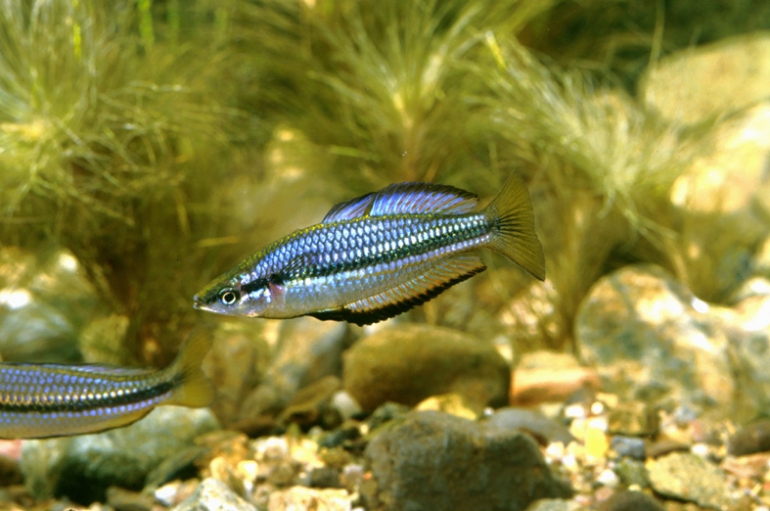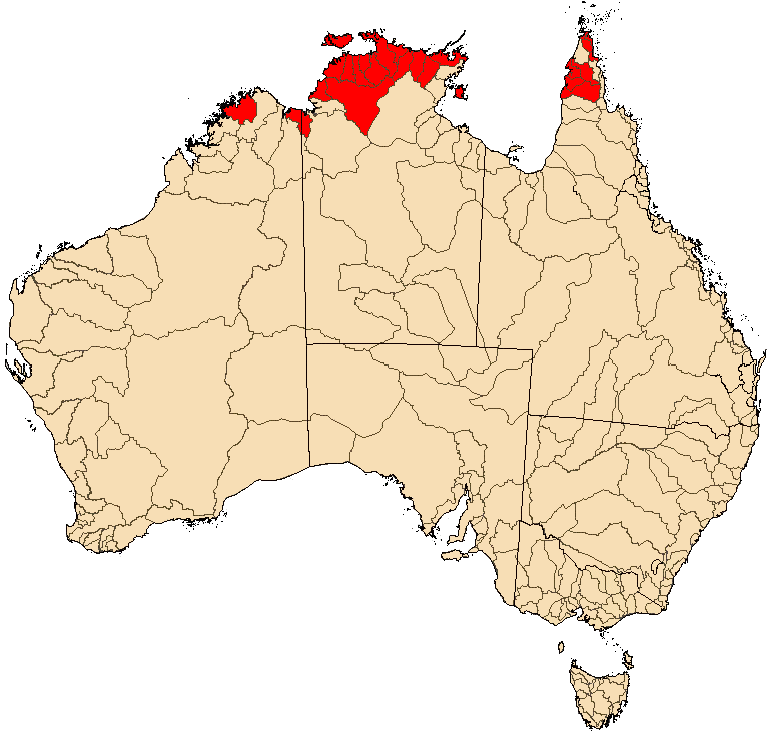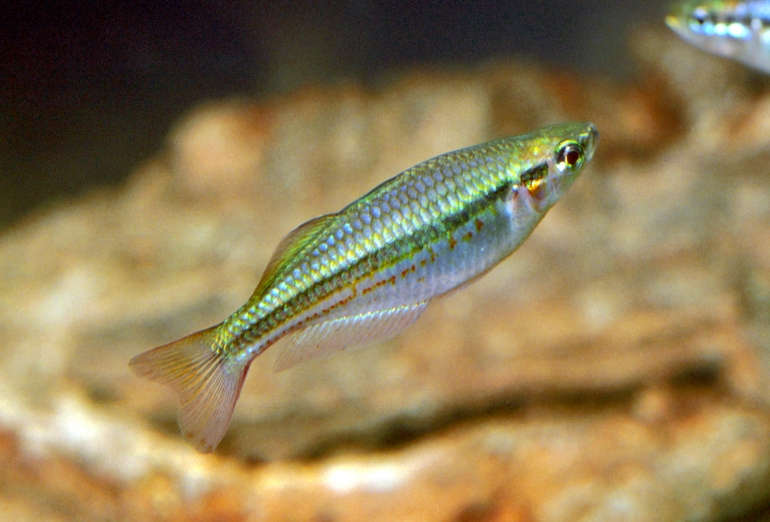|
 |
Melanotaenia nigrans [Scotts Ck, Adelaide River] - photo© Gunther Schmida |
(Richardson, 1843)
Black-Banded Rainbowfish
Species Summary
Melanotaenia nigrans is the type species of the genus Melanotaenia. They were collected by John Gilbert in 1840, from the King River, near Victoria Settlement in the Northern Territory. A single specimen ended up in the British Museum of Natural History in London where John Richardson described it in 1843 as a new species of hardyhead named Atherina nigrans. The differences between Atherina nigrans and the real hardyheads were sufficient enough for the American Thomas Gill to create the genus Melanotaenia for this lone species in 1862, still within the family Atherinidae. The genus name being inspired by the typical black mid-lateral band. The next step was the creation of a subfamily Melanotaeniinae by Gill in 1894 to stress the differences with the hardyheads even more. It took another 70 years however, before Ian Munro elevated them to full family status of Melanotaeniidae in 1964. A full generic classification of the rainbowfishes followed in 1980 by Gerald Allen from the Western Australian Museum.
Melanotaenia nigrans can be recognised by a rather slender body than most other rainbowfishes. They may reach a maximum size of 12 cm, but are usually less than 7 cm. Colouration includes a very dark mid-lateral band running from the snout to the caudal peduncle, about two scales in width. Above the mid-lateral band, the body is silvery with a lavender iridescence. Below the mid-lateral band, there is a thin red stripe. Along the belly, there is a narrow red band from the isthmus to one third along the caudal fin. The nape is pale luminous orange and a bright red opercular spot is apparent. The pectoral fins are a pale luminous orange. The body colour of the females is similar to that of the males but not so intense. However, colour variations can be found in the different geographically located populations. Specimens from the Kimberley region have several lines of dots below the lateral line and red in the fins. Blue colouration in the body and fins is also found in some populations. Colour variability in rainbowfishes has been a source of confusion to both aquarists and taxonomists studying their life history. Colour appears to vary from population to population as well as within a population, particularly during different stages of the fishes' lifespan. This colour variability is related to age, sex, stress, habitat conditions and spawning.
Male and female rainbowfishes usually have different colours and this adds further difficulties to species recognition. In males, the spines of the first dorsal are usually extended and may lie well past the origin of the second dorsal when not erect. The posterior rays of the second dorsal and anal fins are extended caudally and may extend past the origin of the caudal fin. In females, the first dorsal spines are short, not reaching the origin of the second dorsal. The posterior rays of the anal and second dorsal fin are not extended. The spines and outer rays of the ventral fins of some males are also extended and may reach past the vent and the origin of the anal fin. With increasing age and length, the males may develop a very deep body with a distinct nuchal hump and angulated breast which increases the proportional body depth in some rainbowfish species. However, this characteristic is not as marked in M. nigrans.
 |
Distribution Map
(Absence from other catchments may reflect a lack of sampling rather than non-existence.) |
Distribution & Habitat
Melanotaenia nigrans has a discontinuous distribution across northern Australia, from the Kimberley region in Western Australia, across the northern part of the Northern Territory to Cape York Peninsula in northern Queensland, including a number of offshore islands such as Groote Eylandt in the Gulf of Carpentaria and some islands in the Torres Strait. Discontinuous distribution of fish species appears to be a feature of much of the northern Australian fish fauna. A species found in one river system may not necessarily exist in an adjoining system. Most specimens have been collected from the lower reaches of streams within about 50 km of the coast; however, they have been collected in the upper South Alligator River some 130 km upstream. In Western Australia, Melanotaenia nigrans have so far only been collected from Dominic and Pago Creeks; however, they probably occur elsewhere. Dominic and Pago Creeks are small isolated streams between the Drysdale and King Edward Rivers. Pago Creek in the next stream north of Dominic Creek, but it is probably not the correct name and is most likely an unnamed stream. It was just called Pago Creek because it is near Pago Mission (Drysdale River Mission) site which was abandon in 1939. A new mission was established at Kalumburu, about 30 km south of Pago. Unlike other M. nigrans varieties, the Western Australian specimens have a row of reddish-orange dots below the black stripe and may yet prove to be genetically different.
Melanotaenia nigrans have been found in a variety of freshwater environments but seem to prefer slow-flowing clear water streams, billabongs, and swamps with abundant aquatic vegetation. A temperature range of 19-35°C has been recorded in their natural environment; pH 5.0 to 8.1; hardness and alkalinity levels are usually below 50 mg/L CaCO3; and conductivity 4 to 180 µS/cm. M. nigrans is most frequently found in clear waters with sandy substrates, followed by rocks, leaves and mud. They are usually found around sub-surface vegetation, submerged logs, or branches. They are often found in streams with M. trifasciata, M. australis and/or M. splendida inornata.
.GS.jpg) |
Melanotaenia nigrans (Burster Creek, Qld) - photo© Gunther Schmida |
Biology
In their natural environment Melanotaenia nigrans is an omnivore feeding opportunistically across substrates and in surface waters, with possibly less emphasis on mid-water areas. The main food items are aquatic insects, algae and terrestrial insects. The diet varies in relation to the habitat they occupy. In the mainchannel waterbodies they eat mainly aquatic insects, with small amounts of terrestrial insects, plant material and algae. In perennial streams, algae and terrestrial plant material are less important, while aquatic insects and, to a lesser extent, oligochaetes and microcrustaceans, are consumed. The diet in the lowland sandy creekbeds had much larger algal and terrestrial insect components. Specimens examined from the floodplains feed mainly on aquatic arachnids and aquatic insects, and a small amount of algae.
Spawning is possibly continuous, with a few eggs laid at a time, or opportunistic whenever conditions are favourable. Small (less than 20 mm) juvenile fish have been collected in all seasons. Therefore it is difficult to define their breeding season. However, a peak in reproductive activity was recorded during the early-wet season (December-March). Melanotaenia nigrans appears to breed in small streams that contain deep shaded pools with roots and submerged vegetation around the edges. Spawned eggs are adhesive, negatively buoyant in freshwater and average 1.00 - 1.08 mm in diameter, are usually clear to light amber in colour and hang by a fine thread. Usually one to three eggs is deposited at a time, during which time 50-70 eggs can be produced. Survival of eggs is reduced by predation activity of the parents. Many of the eggs are eaten before and after they attach to the plants or other objects. In one study of the ovaries of M. nigrans, the number of eggs ranged from 220 to 500 (mean = 344); egg diameters were not measured. These fish were not mature, so the numbers only indicate developing eggs within the ovary, not how many might actually be shed during spawning.
 |
Melanotaenia nigrans [Pago Creek, WA] - photo© Bruce Hansen |
Remarks
From the very beginning of its introduction to the aquarium hobby, until around the mid 1960s, Melanotaenia duboulayi was mistakenly identified in both Australian and International hobby publications as Melanotaenia nigrans. The real M. nigrans never entered the International hobby until around 1976, when specimens were sent to Europe. Even today it is still being incorrectly identified on some websites. Some sites also incorrectly refer the name M. nigrans to M. australis.
Literature
Allen G.R. (1989). Freshwater fishes of Australia. T.F.H. Publications, Inc., Neptune City, New Jersey.
Bishop K.A., S.A. Allen, D.A. Pollard and M.G. Cook (2001) Ecological studies on the freshwater fishes of the Alligator Rivers Region, Northern Territory: Autecology. Supervising Scientist Report 145, Supervising Scientist, Darwin.
Crowley L.E.L.M., & W. Ivantsoff (l982). Reproduction and early stages of development in two species of Australian rainbowfishes Melanotaenia nigrans (Richardson) and Melanotaenia splendida inornata (Castelnau). Australian Zoology 21(1):85-95.
Herbert B.W., J.A. Peeters, P.A. Graham and A.E. Hogan (1995). Freshwater Fish and Aquatic Habitat Survey of Cape York Peninsula. (Cape York Peninsula Land Use Strategy) Queensland Department of Primary Industries, Brisbane.
Morgan D., M. Sefton, D. Cheinmora, G. Charles and P. Nulgit (2005). Fishes of the King Edward and Carson Rivers, Kawii manya Mararran - nûngka, with the Belaa and Ngarinyin names for the fish. Report to Land and Water Australia.
Richardson J. (1843). Contributions to the ichthyology of Australia (continued). Annals and Magazine of Natural History (New Series) Volume 11 (nos. 67-8, 71-2): 22-28, 169-182, 352-359, 422-428. [Continued from v. 10, p. 34 [ref. 18628], and continues in Supplement to Volume 11, p. 489.
Adrian R. Tappin
Updated April, 2013



|
|

